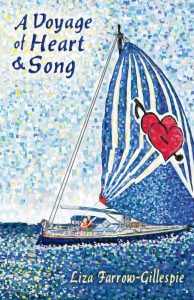Follow along on a journey of a lifetime
 By M. CLARE HAEFNER
By M. CLARE HAEFNER
Life is a journey—embrace it on your terms.
That’s the lesson I look from Liza Farrow-Gillespie’s delightful memoir A Voyage of Heart and Song (Texan Press Inc., 2018). After undergoing treatment for breast cancer at age 38, Liza and her husband, Alan, decided to quit their jobs in Dallas (she’s an attorney, he’s a doctor), buy a boat and pursue their lifelong dream of circumnavigating the globe.
“At that moment…I knew that I did want to go sailing — not just continue to fantasize about it, but actually do it, to go,” Liza writes in the book’s prologue. “Getting cancer was the luckiest thing that ever happened to me.”
Liza chronicles their adventure of a lifetime aboard Heartsong III, which took more than six years, in a lighthearted style that includes excerpts from letters home, entries in the ship’s logbook and articles she penned for publications along the way. Her colorful prose helps readers envision the uninhabited locations where they chose to drop anchor and the harrowing passages through storms.
Throughout their journey, they visited more than 50 countries on six continents. One of their favorite stops was New Zealand, where they spent nearly a year exploring, though Liza often writes that every place became a favorite.
And sometimes, the best parts of the journey were in the middle of the ocean far from land, such as one night when the stars were so bright, Liza says she could almost read by them. “If the West Texas night sky is a skyscraper, then the night sky in the middle of the Pacific Ocean is downtown Manhattan,” she writes.
While the journey can be isolating—they often travel for weeks without seeing another boat—Liza artfully describes the impromptu shore excursions and boat parties they have with friends anchored nearby to her delight at sighting familiar ships again months later on the other side of the world. These passages show the importance of connection and help the reader understand the sense of community and camaraderie that forms among sailors—no one could fend off pirates or travel through the Panama Canal alone.
Though Liza often describes processes on the boat in sailor’s terms, even land lubbers like me can follow along and visualize the activities. She easily explains the mechanics of sailing in a way anyone can understand—maybe that’s because she leaves the complicated tasks of actually repairing broken parts to her “red-headed husband,” whose antics had me laughing throughout the book.
While reading, I often thought about the adventures and other things on my bucket list—vacations and other fun things I often put off for a more opportune time. But as Liza’s experience reminds me, there is no opportune time.
Work will always be waiting and there will always be reasons to say, “not yet.” I have no desire to circumnavigate the globe on a sailboat like Liza and Alan Farrow-Gillespie, but I do plan to embrace the things in life that bring me joy.



